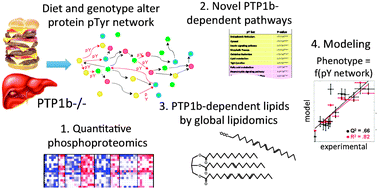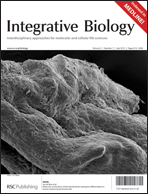Molecular network analysis of phosphotyrosine and lipid metabolism in hepatic PTP1b deletion mice†
Abstract
Metabolic syndrome describes a set of obesity-related disorders that increase diabetes, cardiovascular, and mortality risk. Studies of liver-specific protein-tyrosine phosphatase 1b (PTP1b) deletion mice (L-PTP1b−/−) suggest that hepatic PTP1b inhibition would mitigate metabolic-syndrome through amelioration of hepatic insulin resistance, endoplasmic-reticulum stress, and whole-body lipid metabolism. However, the altered molecular-network states underlying these phenotypes are poorly understood. We used mass spectrometry to quantify protein-phosphotyrosine network changes in L-PTP1b−/− mouse livers relative to control mice on normal and high-fat diets. We applied a phosphosite-set-enrichment analysis to identify known and novel pathways exhibiting PTP1b- and diet-dependent phosphotyrosine regulation. Detection of a PTP1b-dependent, but functionally uncharacterized, set of phosphosites on lipid-metabolic proteins motivated global lipidomic analyses that revealed altered polyunsaturated-fatty-acid (PUFA) and triglyceride metabolism in L-PTP1b−/− mice. To connect phosphosites and lipid measurements in a unified model, we developed a multivariate-regression framework, which accounts for measurement noise and systematically missing proteomics data. This analysis resulted in quantitative models that predict roles for phosphoproteins involved in oxidation–reduction in altered PUFA and triglyceride metabolism.


 Please wait while we load your content...
Please wait while we load your content...